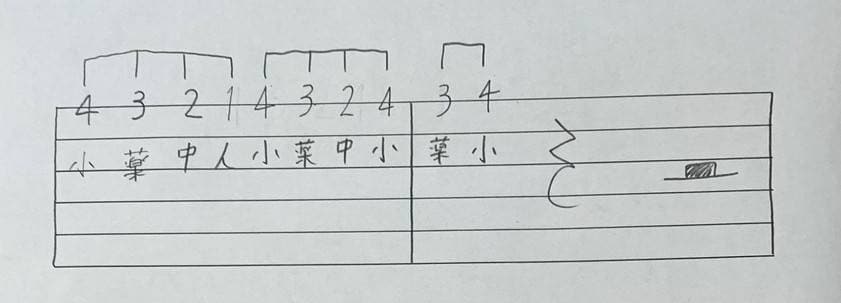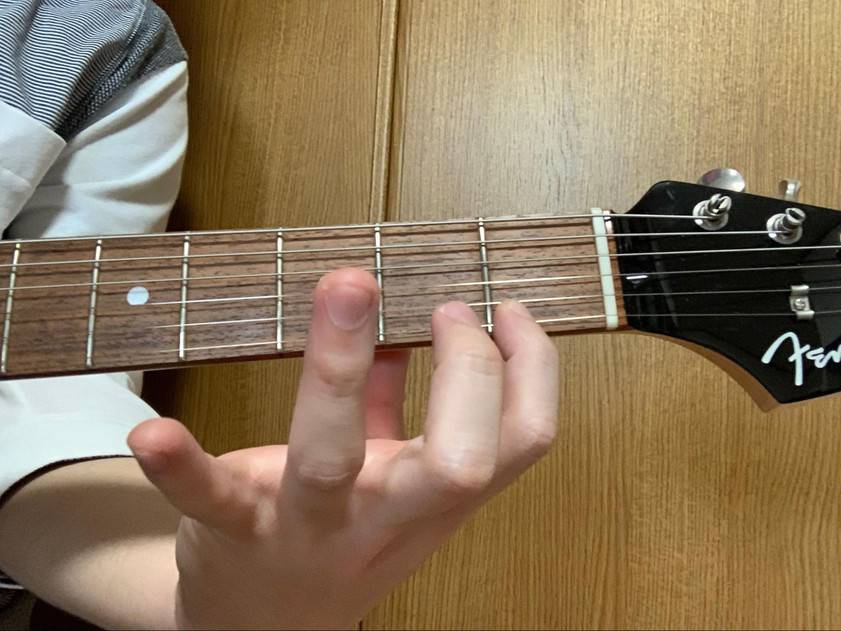Hello, this is Conservario.
Many guitarists, whether beginners or advanced players, often feel that they can’t play as smoothly as they’d like.
There can be many reasons for this, but today, I’ll focus on cases where the left hand—especially the pinky—causes difficulties and introduce a training method to address this issue.
Strengthening the pinky improves overall playing quality.
Be sure to follow along on your guitar as you read through this guide!
Before playing, let’s clarify the goal of this exercise.
The primary focus is strengthening the pinky and balancing all four fingers.
At first, you don’t need to worry too much about rhythm or picking.
Many players want to master everything at once, but as the saying goes, “Chasing two hares will get you neither.” For now, focus solely on your left hand.
Once you’ve understood the purpose, take a look at the sheet music and try playing the exercise.

At first glance, the notation might seem complicated.
So, let’s break it down into simpler parts at first.
This phrase consists of a 10-note segment.
It might be easier to think of it as four notes starting with the pinky, then three notes, then two, and finally one.
This exercise demands constant movement of all four fingers, particularly the pinky.
These movements are not common in typical practice, making them highly effective for strengthening your pinky.
After all, whether you’re a guitarist or not, people rarely use their pinky in daily life.
We don’t tap phone screens with our pinky, nor do we use it when holding cups or plates.
If you practice all four fingers equally, the pinky will always remain weak.
Without dedicated training, your finger balance will worsen over time.
To correct this, the key is to start with pinky movements.
This training method isn’t something I invented but rather a combination of various exercises designed to strengthen the pinky and balance the fingers.
I can confidently guarantee its effectiveness—but it is quite challenging.
Play slowly while following the finger positions in the sheet music.
Taking it slow and practicing carefully is ultimately the fastest route to improvement.
For those who have reached a level where they can play to a certain extent, let’s focus on some more detailed aspects.
When you’re playing, is your pinky unnecessarily lifting off the strings?
When you’re playing with your pinky or ring finger, your pinky should hardly lift off the string.
But what about when you’re using your index finger?
In this practice phrase, when you’re playing with your index finger (1st fret), your middle, ring, and pinky fingers must stay on the strings.
This is the point where you need to pay the most attention.
If the sound from your index finger is clean, there’s no need to lift your fingers off unnecessarily.
Be cautious not to end up like the image shown.

When your fingers are off the strings, that’s not ‘rest time’ for the finger.
Even the fingers that are lifted should be consciously managed, so there’s no wasted movement.
Once you can play a single string without unnecessary movements, the final step is to practice switching strings.
Switching strings is quite difficult.
This is because you need to continuously use your pinky.
You’ll play the last note of the 10-note sequence with your pinky, then immediately switch strings and start again with your pinky.
At this point, there’s no need to rush. Play the last note with your pinky carefully, and then start the next string with your pinky.
If you take too much time switching strings, you’ll tend to play the last pinky note just for a moment and rush to the next string.
Aim to be able to play as if you’re still playing on the same string, even after the string change.
If you can smoothly play this exercise across all six strings, you’ve made significant progress.
From now on, you’ll be able to smoothly use your pinky for both lead and backing parts!
■ Conclusion
I’ve introduced exercises to strengthen the pinky and improve balance.
The pinky is definitely a finger that needs conscious practice.
Considering its frequency of use, if you’re just practicing songs normally, the balance between the four fingers will gradually worsen. That’s why focusing on pinky exercises will gradually improve the balance.
The same can be said for picking.
For example, many people find down-picking easier than up-picking. This is because down-picking is a more natural and commonly used motion.
In such cases, if you focus only on up-picking practice, the balance between down and up picking will improve.
Always be mindful of the purpose and the part of the technique you’re training while practicing.
This way, you’ll become a guitarist who can play with balanced technique in any performance.
Thank you for reading until the end.
The “sound & person” column is made up of contributions from you.
For details about contributing, click here.











![[Guitar Guide] Anyone Can Do It! The Correct Way to Hold a Pick](/contents/uploads/thumbs/5/2022/4/20220419_5_17567_1.jpg)
![[Guitar Guide] Little Nuggets of Guitar Tidbits that Aren’t Well Known](/contents/uploads/thumbs/5/2022/4/20220419_5_17562_1.jpg)
![[Guitar Guide] 3 Essential Studio Practice Etiquette Rules](/contents/uploads/thumbs/5/2022/4/20220419_5_17560_1.jpg)
![[Guitar Guide] 3 Recommended Handy Items](/contents/uploads/thumbs/5/2022/4/20220419_5_17555_1.jpg)
![[Guitar Guide] Basic Practice for Mute Strumming](/contents/uploads/thumbs/5/2022/4/20220419_5_17543_1.jpg)
![[Guitar Guide] Training for Left Hand, Right Hand, and Mind](/contents/uploads/thumbs/5/2022/4/20220419_5_17539_1.jpg)
 DIY ギターメンテナンス
DIY ギターメンテナンス
 ギターの種類
ギターの種類
 ギター演奏に必要なものは?
ギター演奏に必要なものは?
 ギター名人ラボ
ギター名人ラボ
 ギタースタートガイド
ギタースタートガイド
 めちゃラク!ギター講座
めちゃラク!ギター講座















